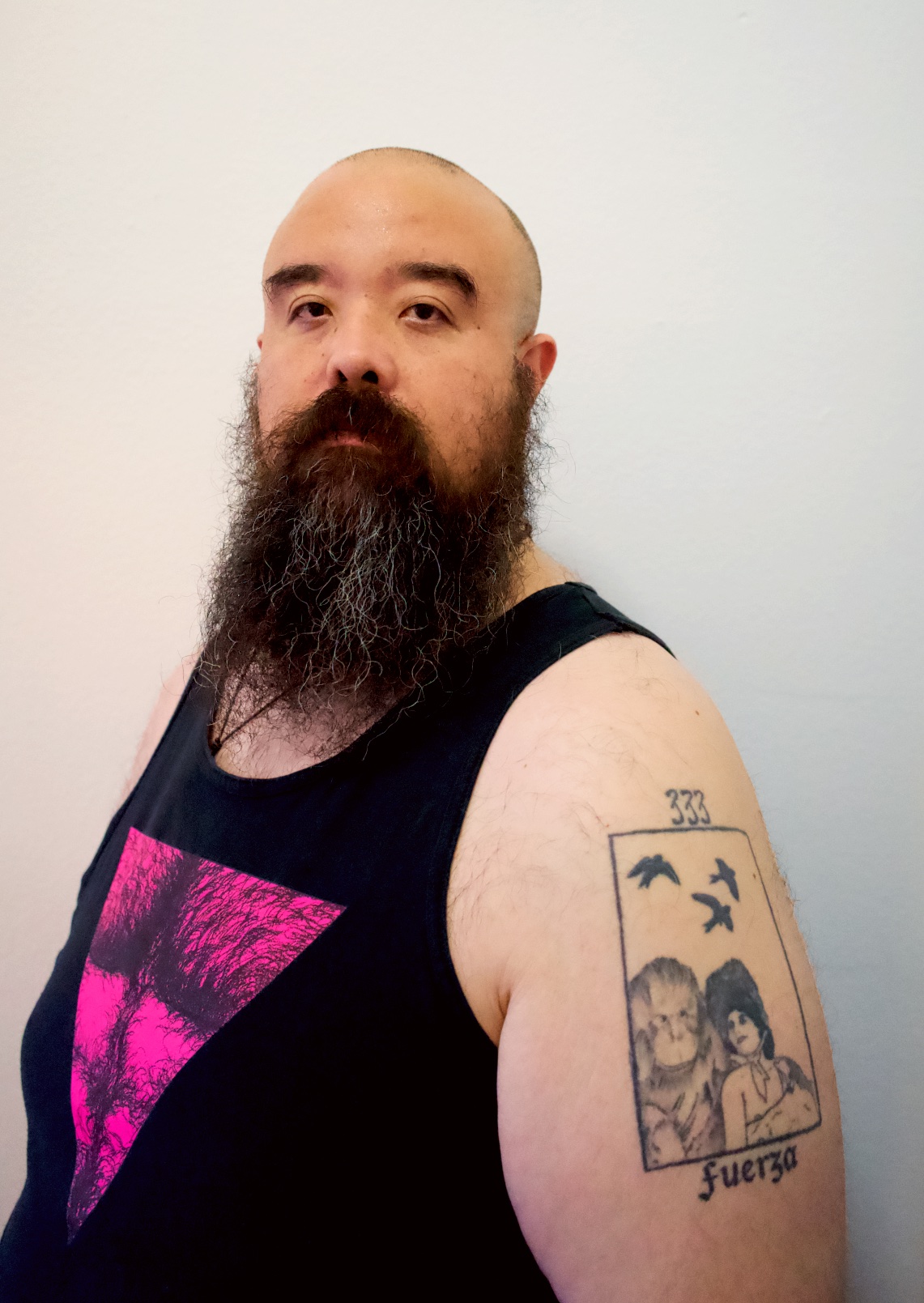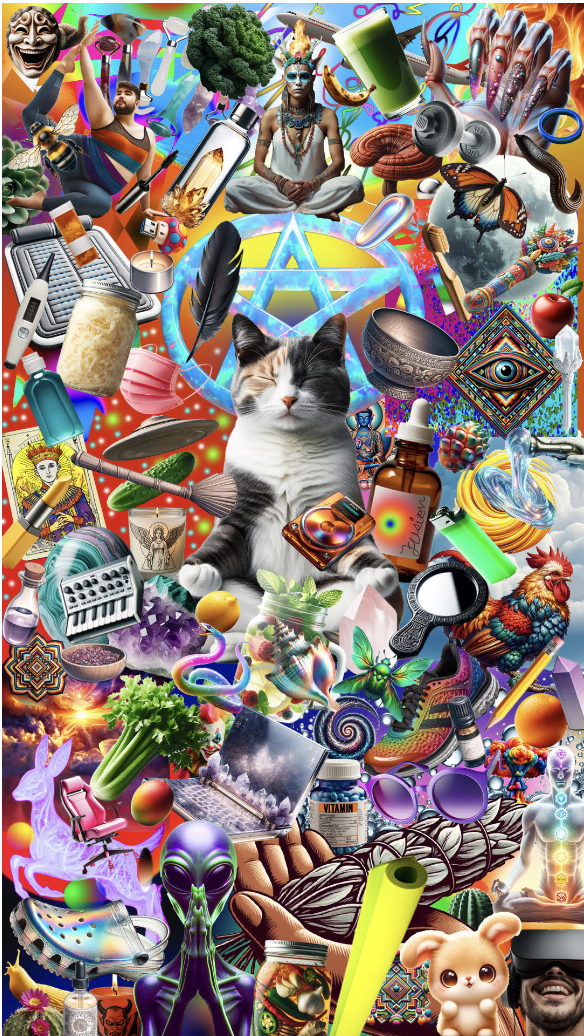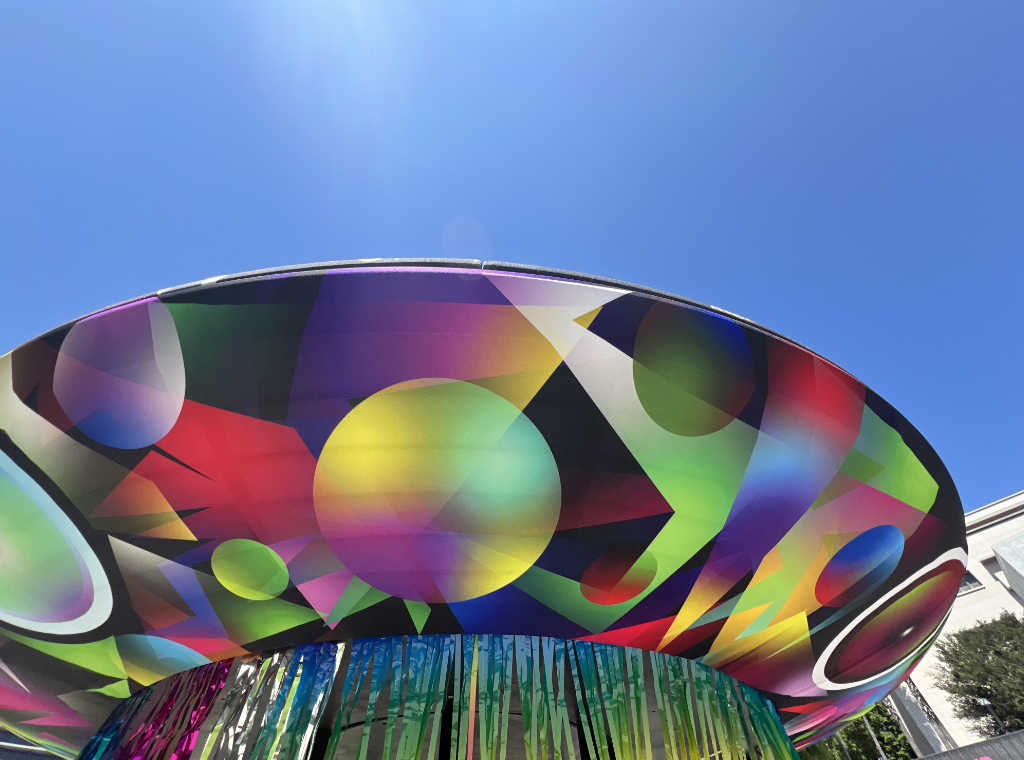PUBLISHED SEPTEMBER 4, 2024
Archive of Healing Director, Dr. David Delgado Shorter, reached out to Frías to discuss connections between healing and art. Frías will be unveiling their new public art piece, VESSEL, on September 8th in Gloria Molina Grand Park, DTLA; more here: https://www.eventbrite.com/e/vessel-activation-celebration-at-grand-park-tickets-1001610452827
Edgar Fabián Frías works in installation, photography, video art, sound, sculpture, printed textiles, GIFs, performance, social practice, and community organizing, among other forms. Frías is Wixárika and their family is from Mexico, though they have lived in the United States for most of their life. Their art addresses historical legacies and acts of resistance, resiliency, and radical imagination within the context of Indigenous Futurism, spirituality, play, pedagogy, animism, and queer aesthetics. Weaving together the traditional and ancestral with the contemporaneous and emergent.
Born in East Los Angeles in 1983, Frías received dual BA degrees in Psychology and Studio Art from UC, Riverside. In 2013, they received an MA in Clinical Mental Health Counseling at Portland State University in Portland, Oregon, with an emphasis on Interpersonal Neurobiology and Somatic Psychotherapy. Frías received their MFA in Art Practice from UC Berkeley in 2022.
Their work has been exhibited internationally, including the Vincent Price Art Museum, Institute of Contemporary Art San Francisco, Berkeley Art Museum and Pacific Film Archive, Oregon Contemporary, MOCA Jacksonville, Project Space Festival Juárez, and ArtBo, among others. Their work has appeared in Cosmopolitan, Taschen, Bustle, Los Angeles Times, Slate, CVLT Nation, Terremoto, Hyperallergic, and other publications.
"I am slippery. I exist within several dimensions and I am from here and from there, I belong everywhere; makuyeika. I am a dreamer and have a deep connection with plant, animal, and crystalline kin. I receive messages from my ancestors and have been gifted the role of being an interlocutor, a leader, a listener, a healer, and a visionary. I am a part of a sacred lineage and I am forever mutating into new forms and possibilities; in relationship."

Figure 1: Headshot of Edgar Fabián Frías, by Thaddeus Pedisich
AH: You often talk about art as ceremony or spells. What is it about “arting” that provides humans with the level of life-affirming creative force that some religious studies scholars associate with rituals and rites?
EFF: Art has a unique capacity to create sacred space, where our deepest emotions, desires, and existential experiences can be held and explored. As a witch, I understand that in ceremony, we carve out this space, reconnecting with the ancestral, the embodied, and the emergent. This sacred process naturally unfolds in art-making as well. We create space by choosing our medium, becoming contemplative, and opening ourselves to messages and support. We channel, praise, and connect deeply with our intuition and vision when we make. We tune into the creative force within and without. I have received countless visions within the altered state of art-making and have conversely received guidance during deep states of meditation, divination, and prayer regarding my art practice and even for specific projects.
Art also serves as a vehicle for transmitting sacred information and energies. Indigenous people have long understood this, using art to share transcendental experiences and important messages received in dreams, ceremonies, and rituals. Through art, we can take something ephemeral and fragile and transform it into something lasting, capable of being transmitted across time and space.
AH: You are constantly mixing trans, queer, Latine, Wixarika, and Indigenous influences and biographical impulses in your art. And of course much is public and performative. Do you find yourself wrestling with how much of those histories and texture are for outsiders as opposed to for insiders? I’m thinking here of the difficulty for many Indigenous artists to both process and yet share histories of violence or erasure.
EFF: This question touches on a deeply personal and complex aspect of my work, and I appreciate the opportunity to reflect on it.
When I create art, I'm constantly navigating the space between my own lived experiences and the broader histories and communities I am part of, including the trans, queer, Latine, Wixarika, and Indigenous identities that are central to who I am. My work is deeply informed by these intersecting identities, and it often serves as a bridge between my personal journey and the collective experiences of those who share these histories.
One of the challenges, as you've mentioned, is deciding how much of these histories and textures are for insiders versus outsiders. For many Indigenous artists, including myself, there's a delicate balance between sharing our stories and protecting them. These histories often carry the weight of trauma, violence, and erasure, and presenting them in a public, performative way requires careful consideration of the context and audience.
In my work, I strive to create spaces where these stories can be honored in a way that is both authentic and protective of the communities they represent. I believe in the power of art to facilitate healing and understanding, and I see my role as one of translating these experiences into forms that can resonate with a broad audience while still maintaining the integrity of the source.
This balance is not always easy, and it's something I continuously wrestle with. But ultimately, I hope that my work can serve as a vessel for these stories, allowing them to be shared in a way that is respectful and empowering for those who have lived them.
AH: The vibe I’m getting from so many in my community is heavy and somber about the future of the planet, political world, and even our cities. How are you holding up; or rather, how might our readers gain some insight into your daily management of the emotions that arise for you?
EFF: The weight of the current state of the world is something I feel deeply, just as many others do. There’s a profound sense of heaviness, as we face so many daunting challenges—environmental, political, and societal. In navigating these emotions, I find that my art serves as a powerful mirror, reflecting back to me what is happening both within myself and in the world around me.
Creating art is a way for me to hear and see the subtle, often hidden currents of my emotions and thoughts. It helps me to process the intensity of what I’m feeling and offers a way to engage with those feelings constructively. Through this practice, I can hold space for the distress and despair that is so prevalent, while also seeking out the glimmers of hope that still exist.
Part of my spiritual practice is to remain anchored in the possibilities of natural cycles, healing, and transformation. I trust that even in the darkest times, there is potential for change and renewal. This doesn’t mean ignoring or downplaying the severity of our current reality—it’s essential to acknowledge just how dire things are. But I also believe in the resilience of Spirit, which remains alive even in the deepest darkness.
My role, as I see it, is to be someone who can guide others toward this Spirit, to help kindle and maintain that vulnerable flame of hope. It’s a delicate balance of holding onto hope while also caring for and protecting it, recognizing that this is an ongoing process that requires attention and intention.
I hope that by sharing my own practices, others can find ways to navigate their own emotions during these challenging times, using whatever creative or spiritual tools resonate with them to hold onto the light amidst the darkness.

Figure 2: I Am On My Healing Journey, 2024. Courtesy of Edgar Fabián Frías
AH: While we’re here in this sensitive space, I wanted to know how much you associate your art making practice with your own healing process. I think about that old saying of “healer heal thyself” as if you absolutely must first heal before you can help others. I’m not so sure. How has it been for you?
EFF: My art-making practice is deeply intertwined with my healing process—it’s impossible for me to separate the two. The old saying "healer, heal thyself" resonates with me, but not in the sense that I must be fully healed before I can help others. Instead, I see healing as a continuous journey, one that informs and is informed by my art.
Some of my deepest wounds stem from not being seen, heard, or valued, especially growing up in a society that often neglects or erases the histories of communities that don't conform to white supremacist, cis-heteronormative, patriarchal structures. Despite this, I've always had a profound desire to be an artist and share my thoughts, feelings, and visions with the world. I was told that being an artist was a pipe dream, that only a small percentage make a living from it, and that I might never "get there." And in many ways, that remains true—things are still precarious, and the realities of racism, homophobia, transphobia, and classism are ever-present.
Yet, being an artist has allowed me to dream of other possibilities. It has connected me with people all over the globe, helping me build a sense of self that aligns with my true purposes. Art has provided a way for me to exist within this capitalist hellscape in a way that allows me to thrive, living off both my artistic and therapeutic practices. It has enabled me to collaborate with and create alongside others worldwide, stepping into my power more deeply.
Art is so much more than the objects I create—it’s an orientation, a way of living, and a means of crafting a life worth living. It provides a space where I can process, experiment, fail, and ultimately create meaning for myself and others. In this way, my art is not just a reflection of my healing; it is an active part of it, continually helping me heal while also offering that healing to others through the connections and experiences it fosters.
AH: In the last few months, I have seen some great friends create or contribute to some fantastic oracle decks, such as Leonardo Bravo (Itinéraires Fantômes Oracle Deck) and Enid Ryce Baxter (Borderlands Taro). As an academic, I rarely feel safe to talk about the connectedness I feel with my decks when I read. And I know that you regularly do readings as performances so I know you have first-hand experience in decks. You have said that the “Missing Witches Deck of Oracles” has left you shaken. Please expand on this by way of answering the most skeptical of questions: How can randomness (such as a card shuffle) be a key to understanding authentic messaging?
EFF: I don’t see it as randomness. Over the years, I’ve done hundreds of readings, and each one continues to amaze me with how direct, incisive, and revealing they can be. Divination, to me, is a profound way of opening our hearts and minds to the source, to spirit, and to the ancestral realms. What might appear as random actions to some are, for me, imbued with spirit and meaning. They are a means of communion.
Take, for instance, the reading you’re referring to, where I "randomly" drew the card of Maria Sabina. Maria Sabina has been a deep and powerful influence on me as a healer, an artist, and a visionary. It felt as though she had found a way to cut through all the noise and clutter that often fills our lives and speak to me in a manner that was truly profound, so much so that it left me shaken as I shared it.
When I do a reading, I feel a presence guiding me, and I often receive messages. There is nothing random about it for me; these are deeply guided experiences that inspire a profound sense of communion and contemplation. I absolutely love the decks you mentioned. I am deeply honored to be in the same deck as Leonardo, the Itinéraires Fantômes Oracle Deck (Itinéraires Fantômes Oracle Deck). It’s a beautiful work of art that I’m thrilled to be a part of. I also recently received Enid’s bilingual Borderlands deck, and it’s so heartwarming and beautiful! It’s the deck I wish I had growing up as a bilingual baby witch, and I can’t wait to buy it for friends. I’m hoping to share a review on it soon on my YouTube channel.
For skeptics, I would say that it’s important to approach divination with an open mind, much like you would any other form of exploration or inquiry. Rather than focusing on the mechanics of shuffling cards or drawing lots, consider the experience as an opportunity to tap into deeper layers of consciousness and meaning. The process of divination can be likened to a mirror—one that reflects not just surface-level thoughts, but the subconscious and spiritual energies that influence our lives. By setting aside the need to rationalize every detail and allowing yourself to engage with the process, you might find that the messages you receive resonate in ways that are unexpectedly profound. In this way, divination is less about predicting the future and more about connecting with aspects of yourself and the world around you that often go unnoticed in our everyday lives.

Figure 3: Edgar's artwork, Vessel, at Grand Park. Photo by Edgar Fabián Frías.
AH: You are always up to intriguing things. I saw you were listed as one of the “top ten” art exhibits to catch in LA, in Hyperallergic I think (Hyperallergic). And as we discussed before, you have your art up on the moon now (Art on the Moon). How do you as an artist maintain the productivity needed for income while also maintaining self and kin care?
EFF: I approach productivity and balance through the lens of my human design and astrology. As a Manifesting Generator with my moon in Scorpio, I naturally thrive on having many different projects to work on. I love uncertainty, diving deep into the unknown, and expanding my capacities in ways that are thrilling, scary, and unfamiliar. While this lifestyle might sound exhausting or even horrifying to some, for me, it’s nourishing and keeps me grounded and centered.
To maintain this balance, I’ve structured my life in a way that supports both my art and my well-being. I have a private practice as a therapist that I run one day a week, which meets most of my financial needs. This setup allows me to dedicate the rest of my time to my art practice while ensuring I have space every week for rest, play, and connection with my communities. Because my income doesn’t depend solely on my art, I feel more freedom to dream, take bigger risks, and embrace experimentation and innovation without the pressure to monetize every aspect of my creative work.
However, it’s also important for artists—and anyone on an entrepreneurial path—to learn about the business side of things. Business, marketing, contracts, and other "boring" or uncomfortable aspects of being an artist are crucial, yet they are often overlooked in art education. This oversight is deeply problematic, especially for artists of color who may not have the same access to resources or knowledge as others. When I was at UC Berkeley’s MFA program, our cohort was the first-ever to be all people of color. There was a sense that talking about money or business was "beneath us" or not what we were there to learn. But I believe these conversations are essential. I’m incredibly grateful to my advisor, the iconic artist Stephanie Syjuco, who understood the importance of these topics and made space for them, even when others didn’t.
As I continue to grow, one of my goals is to have my art sustain me more financially while still feeling emergent, experiential, and innovative. If you have any insights on how to achieve this, I’m all ears.